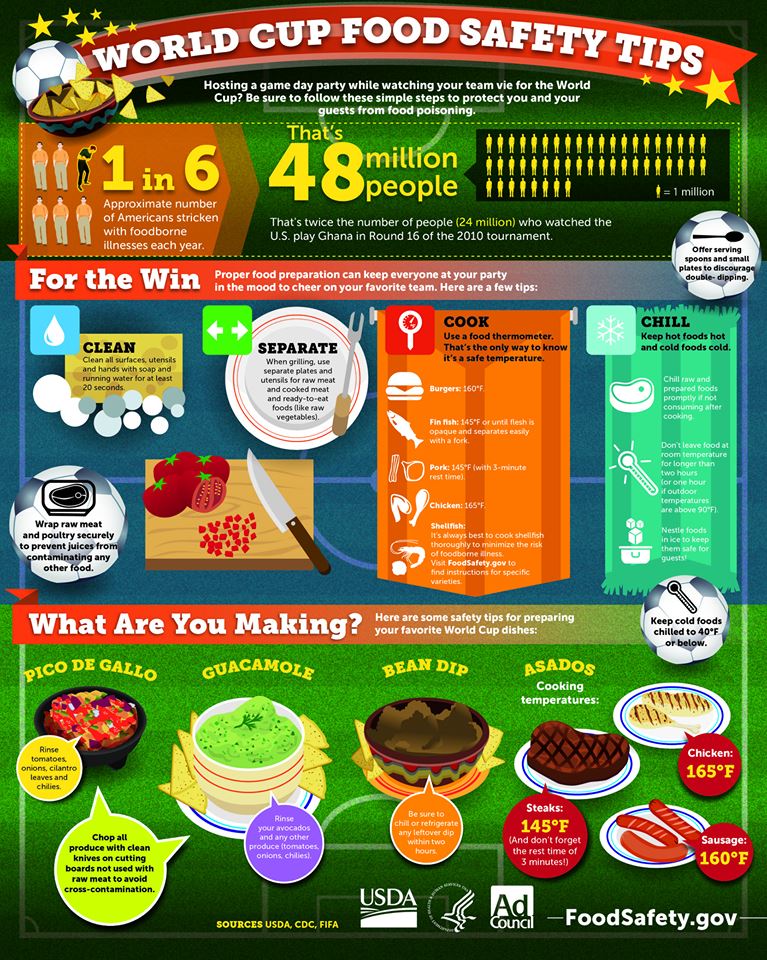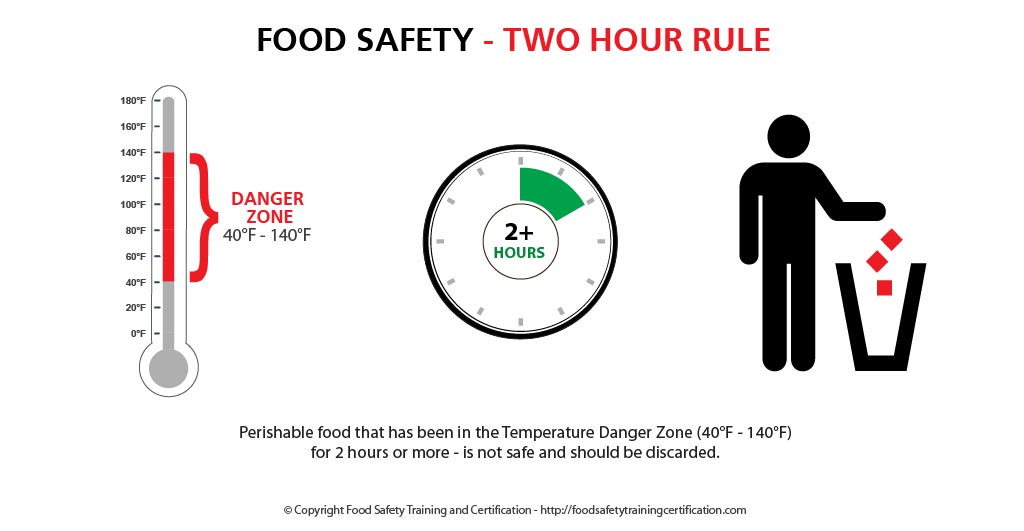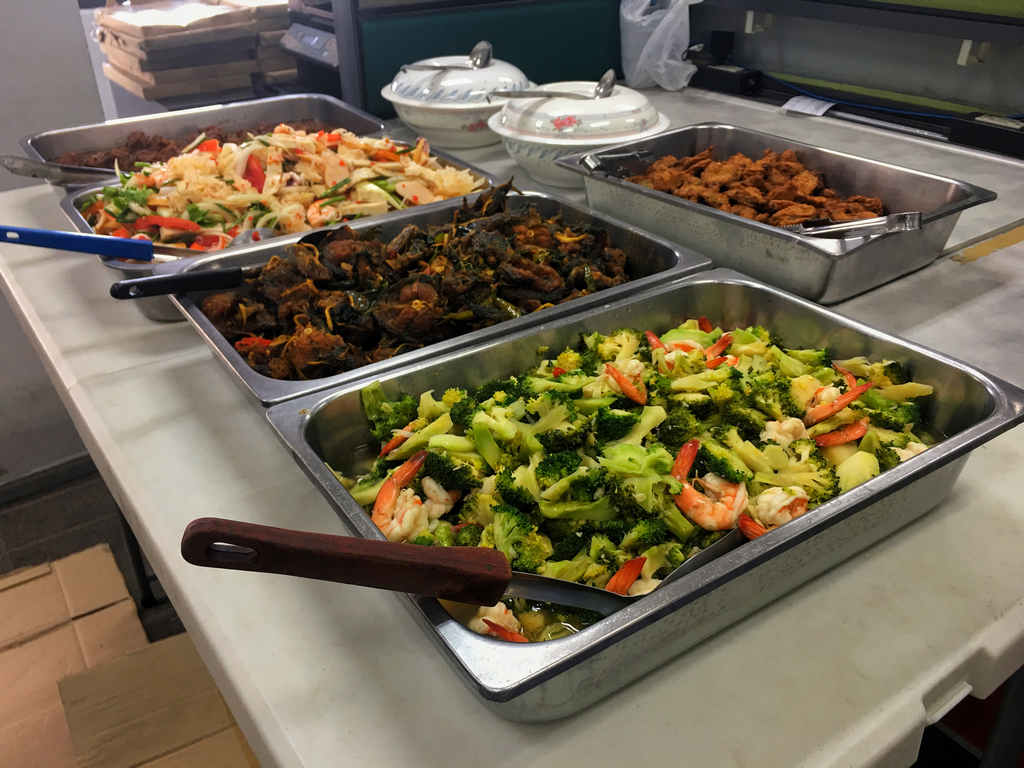Are your going to support your favorite team and host a World Cup Party? For some sports fans, the World Cup is basically an extended celebration — after all, this tournament only happens once every four years.
#WorldCup and #FIFAWomensWorldCup fans like to get their friends and family together to cheer on their favorite country with fun party food and drink ideas. But don’t take your eye off the ball when it comes to food safety. Follow simple food safety tips to keep your party free from food illness.
 Image Source: Shutterstock
Image Source: Shutterstock Food Illness Causes
Food illness has many causes. Primarily because of leaving food out too long. But, food illness generally occurs when people eat food that contains bacteria, parasites, viruses, or toxins. Most cases are caused by common bacteria such as staphylococcus or E. coli.
- Learn about foodborne pathogens, cross contamination, cold and hot food safety, and best practices to prevent foodborne illness.
- Food Manager ANSI Certification: $99.00 - Valid in all States
- Food Handler Training: Only $7.00!
- 10% OFF: Enter Promo Code "train10off" at Checkout
Four Food Safety Steps – Clean – Separate – Cook – Chill
One in six Americans will get sick from food poisoning each year. By following four simple food safety steps, you can help keep your family safe from food poisoning at home.

Clean
- Begin your party food prep by washing hands with warm, soapy water for at least 20 seconds.
- Wash and sanitize dishware and utensils before using them to prepare, warm, cook or serve any foods.
Separate
- Don’t cross-contaminate your food.
- Keep all raw meat and poultry away from ready to eat foods while preparing and mixing items.
- Use clean and different utensils for each dish, and avoid using your own personal utensil to serve yourself foods from the buffet.
Cook
Use a food thermometer to ensure that all meats, poultry and other cooked food items have been cooked to a safe internal temperature before serving. Any previously cooked foods being reheated must be reheated to a safe internal temperature of 165°F, or steaming hot before serving.
Making sure food items are properly heated and cooked will kill bacteria that may try to tackle your guests. Refer to the Safe Minimum Cooking Temperatures chart below for the “rest time” of meats—the period after cooking that some meats need to rest before serving to ensure that germs are killed.
Here are the recommended internal temperatures for some party favorites:
| Category | Food | Temperature (°F) | Rest Time |
|---|---|---|---|
| Ground Meat & Meat Mixtures | Beef, Pork, Veal, Lamb | 160 | None |
| Turkey, Chicken | 165 | None | |
| Fresh Beef, Veal, Lamb | Steaks, roasts, chops | 145 | 3 minutes |
| Poultry | Chicken & Turkey, whole | 165 | None |
| Poultry breasts, roasts | 165 | None | |
| Poultry thighs, legs, wings | 165 | None | |
| Duck & Goose | 165 | None | |
| Stuffing (cooked alone or in bird) | 165 | None | |
| Pork and Ham | Fresh pork | 145 | 3 minutes |
| Fresh ham (raw) | 145 | 3 minutes | |
| Precooked ham (to reheat) | 140 | None | |
| Eggs & Egg Dishes | Eggs | Cook until yolks and white are firm |
None |
| Egg dishes | 160 | None | |
| Leftovers & Casseroles | Leftovers | 165 | None |
| Casseroles | 165 | None | |
| Seafood | Fin Fish | 145 or cook until flesh is opaque and separates easily with a fork. | None |
| Shrimp, lobster, and crabs | Cook until flesh is pearly and opaque. | None | |
| Clams, oysters, and mussels | Cook until shells open during cooking. | None | |
| Scallops | Cook until flesh is milky white or opaque and firm. | None |
Watch the Time – Leftovers
The game is over, but that doesn’t mean you have to lose your food or your health! Track the time that food stays on the buffet. Sideline any perishable foods that have been out at room temperature for 2 hours or more.

Chill
After foods have been sitting at room temperature for 2 hours, either place foods in the refrigerator, change the cold sources or throw out foods you know have been sitting since pre-game coverage.
- Bacteria love temperatures between 40°F and 140°F, and will grow rapidly if they are in this temperature environment for more than 2 hours. Read more about the Danger Zone.
- Divide leftovers into smaller portions or pieces, place in shallow containers, and refrigerate.
- Leftover foods should be refrigerated at 40°F or below as soon as possible and within two hours of preparation. It’s OK to put hot foods directly into the refrigerator.
- Refrigerate leftovers for three to four days at most. Freeze them if you won’t be eating the leftovers sooner.
- Leftovers should be reheated to at least 165°F (74°C) before serving.
Buffets – Size, Time and Temperature
Buffets are a great way to serve food when gathering to watch “the big game.” To keep the food your are serving buffet style free from dangerous bacteria, remember three key things: size, time and temperature.
 Image Source: Shutterstock
Image Source: Shutterstock Size. Size refers to the size of the platters or portions you put on the buffet table. Don’t put all your food out at once. Instead, divide what you have prepared onto a number of small platters and dishes ahead of time, and replace them with fresh ones throughout the party. Don’t add new food to an existing serving dish. Bacteria from people’s hands can contaminate the food and the dish.
Time. Bacteria multiply rapidly at room temperature. Two hours is the maximum. Perishables should not be left out at room temperature for more than two hours, one hour if the buffet is held in a place where the temperature is above 90°F. Throw out all perishable foods when they reach this time unless you’re keeping it hot or cold, which brings us to temperature.
Temperature. You need a food thermometer to make sure food is being held or served at the proper temperature. Hot foods should be kept at an internal temperature of 140° F or warmer. Cold foods should be kept at 40° F or colder. Until guests arrive, keep cold dishes refrigerated and hot dishes in the oven set at 200° F to 250° F.
